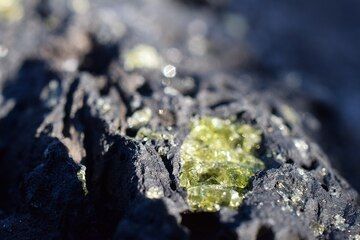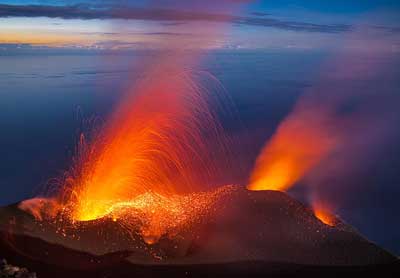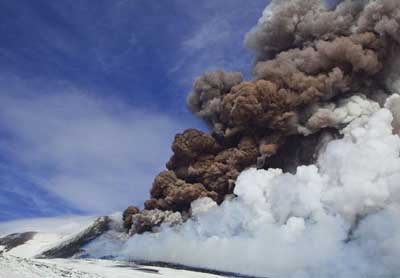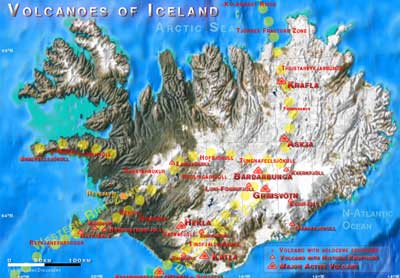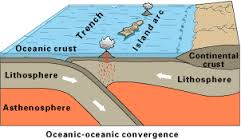Earthquakes
Generally, acceleration is increase of speed or velocity. During earthquakes, the shaking of ground is a swinging motion involving both acceleration and deceleration.
Its maximum value is the largest increase in velocity recorded at a particular point. It largely influences how damaging an earthquake is in this area.
Volcanology
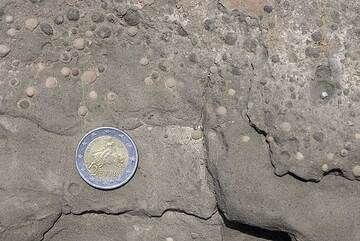
Accretionary lapilli in an ash deposit on Santorini.
Small spherical balls of volcanic ash
Accretionary lapilli are small spherical balls of volcanic ash that form from a wet nucleus falling through a volcanic ash cloud. They can flatten on hitting the ground or may roll on loose ash and grow like a snowball.
Volcanology
An adjective describing the chemical composition of magmas (or lavas) having relatively high content of silica (SiO2). It has little to do with the use of the term in chemistry where it is used to describe low pH values found in acids.
In petrology and volcanology, magmatic rocks (or the magmas they derived from) are often classified by their bulk silica (SiO2) content, which can typically range from around 40-75 weight %, an results in the 4 main types of magma by composition. These are, in order of increasing silica content: basaltic (45-53%), andesitic (53-62%), dacitic (62-69%), and rhyolitic (69-77%).
Rocks with high sili...
Earthquakes
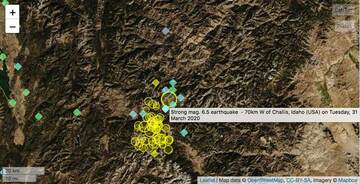
Aftershocks following the M6.5 quake in Idaho on 31 Mar 2020
Aftershocks are smaller quakes that follow a usually larger earthquake in the same rupture zone. The can occur up to weeks, months or even years after, depending on the size of the main shock.
Aftershocks are smaller than the mainshock and occur within 1-2 rupture lengths distance from the mainshock.
In general, the larger the mainshock, the larger and more numerous the aftershocks, and the longer they will continue. Large earthquakes can be followed by thousands of aftershocks.
The larger aftershocks following an earthquake can be particularly dangerous if many structures have been ...
Minerals
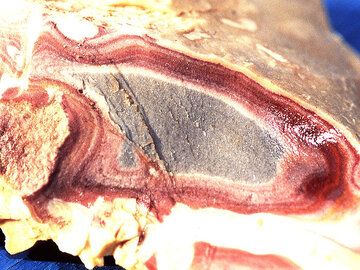
Agate from Milos island, Greece
Agate is a microcrystalline variety of quartz (silica), chiefly chalcedony, characterised by its fineness of grain and brightness of color.
Agate is a microcrystalline variety of quartz (silica), chiefly chalcedony, characterised by its fineness of grain and brightness of color. Although agates may be found in various kinds of rock, they are classically associated with volcanic rocks but can be common in certain metamorphic rocks.
Colorful agates and other chalcedonies were obtained over 3,000 years ago from the Achates River, now ca...
Earthquakes
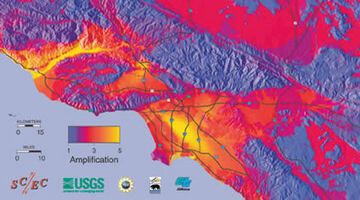
Amplification of earthquake waves in the LA area (image: USGS)
Amplication is the effect of increasing seismic shaking as a result of surface or subsurface topography and geology at a given spot. Various factors can focus seismic energy, in particular the geometry and composition of the rock or sediment strata.
Amplification occurs when seismic waves are reflected or bended and overlap with themselves or other seismic waves from the same quake.
Two important local geologic factors that affect the level of shaking experienced in earthquakes are (1) the softness of the surface rocks and (2) the thickness of surface sediments.
Areas near steep cliffs are particularly prone to seismic wave amplification. At such exposed surfaces, seismic waves are reflected and overlap to create larger waves in a similar way as water waves increase when hi...
Earthquakes
The maximum displacement of points on a wave from their equilibrium position. We measure the amplitude of seismic waves generated by an earthquake using a seismogram. The size of the waves on the seismogram gives us the amplitude.
Volcanology
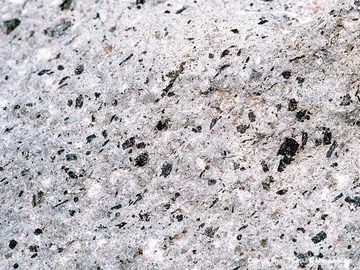
Typical andesite from the Methana peninsula (Greece)
Andesite is a gray to black volcanic rock with intermediate silica content, typical for lava domes and stratovolcanoes in subduction zones.
Andesite is an igneous volcanic rock containing between about 52 and 63 weight % silica (SiO2). Andesite is the extrusive equivalent to plutonic diorite - if a dioritic magma cools beneath the surface as an intrusion, it will be diorite, if the same magma erupts during a volcanic eruption, the rock formed is andesite.
Where does andesite usually occur?
Andesite and diorite are among the m...
Volcanology: volcanic ash
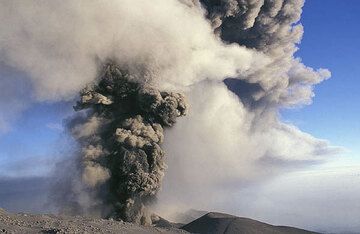
Ash plume from an explosive eruption at Etna volcano (Italy)
Volcanic ash is the term for all fine-grained volcanic products (smaller than 2 mm), normally magma or older rock fragmented during explosive eruptions.
Volcanic ash has nothing to do with fire, but is a mere definition of grain-size. Ash can range in size from sandy to extremely fine; any fragment ejected by a volcano less than 2 mm in diameter is called ash. It may consists of freshly ejected lava (usually turned into a glass shard because of rapid cooling), older fragmented rock, or small crystals.
Ash is produced by explosive activity when ex...
Volcanology: volcanic ash fall
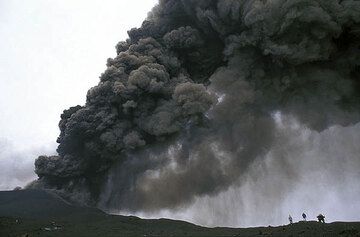
Ash plume and ash fall from Etna during the eruption in 2002
Volcanic ash fall is the deposition of ash from the air from eruption plumes emitted during explosive volcanic eruptions.
Related keywords (1):
ashGeology
The uppermost viscous layer of the mantle where pressure and temperature conditions can allow partial melting of the mantle rocks, which forms magmas.
From the Greek "asthenos"=weak and "sphera"=sphere, the asthenosphere is the uppermost layer of the plastic, highly viscous mantle beneath the brittle crust. It extends to depths of 100-200 km.
Because the pressure in this zone is still comparably low while temperature is high, parts of the mantle rocks can be in a molten state and form magmas. This happens especially in areas where pressure is ...
Earthquakes
Seismic waves are largest at the source of the earthquake, and decrease in size as they move further away. This decrease in size or amplitude of waves is called attenuation.
Related keywords (2):
amplitude -
seismic wavesVolcanology
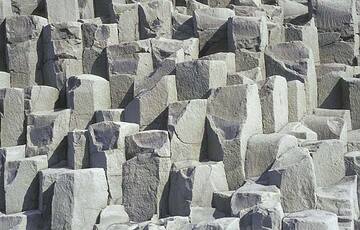
Basaltic columnar-jointed lava (Iceland)
The most common type of volcanic rock, with a relatively low silica content and typically erupted at shield volcanoes.
Basalt is the usually hard and black volcanic rock formed from (liquid) balsalitc lava. Balsaltic lava contains less than about 52 percent silica (SiO2) by weight. Because of its low silica content, it has a low viscosity (resistance to flow). Therefore, basaltic lava can quickly and easily flow more than 20 km from a vent. The low viscosity typically allows volcanic gases to escape without genera...
Volcanology
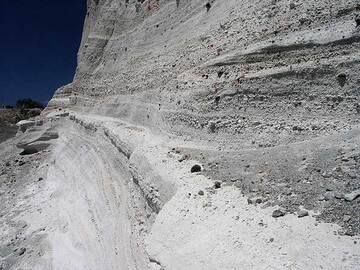
Base surge deposits from the great Minoan eruption on Santorini (ca. 1613 BC)
Base surges are ground hugging, fast outward moving and turbulent, dilute clouds of gas and ash. They result from water magma interactions (violent steam explosions). During the 1965 eruption of Taal volcano (Philippines), such base surges were first observed. Some of them traveled 4 km and killed 189 people. Base surges were first identified during ocean nuclear weapons explosions in the Pacific....
Volcanology
An adjective describing the chemical composition of magmas (or lavas) having relatively low content of silica (SiO2), as opposed to "acidic", and a comparably high content of iron and magnesium.
In petrology and volcanology, magmatic rocks (or the magmas they derived from) are often classified by their bulk silica (SiO2) content, which can typically range from around 40-75 weight %, and results in the 4 main types of magma by composition. These are, in order of increasing silica content: basaltic (45-53%), andesitic (53-62%), dacitic (62-69%), and rhyolitic (69-77%).
Rocks with low sili...
Minerals
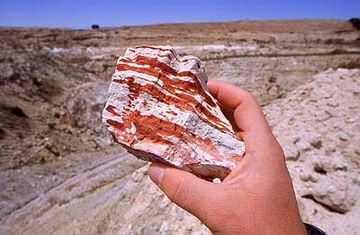
Bentonite from the Greek island of Milos
Bentonite is an absorbent aluminium phyllosilicate generally impure clay consisting mostly of montmorillonite.
Bentonite is an absorbent aluminium phyllosilicate generally impure clay consisting mostly of montmorillonite. There are a few types of bentonites and their names depend on the dominant elements, such as K, Na, Ca, and Al. As noted in several places in the geologic literature, there are some nomenclatorial problems with the classification of bentonite clays. Bentonite usually forms from weathering...
Volcanology: (volcanic) block
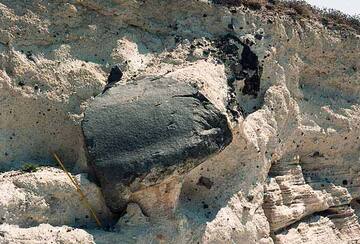
Large ballistically ejected block on Santorini (Greece)
Volcanic blocks are solidified rock fragments greater than 64 mm in diameter. Blocks commonly are ejected during explosive eruptions and consist of older pieces of the volcano's edifice, e.g. parts of the conduit, lava domes or older lava flows.
During violent eruptions, blocks of up to several meter size can be thrown to several km distance. For example, during the Minoan eruption (ca. 1613 BC) of the Santorini volcano in Greece, meter-sized blocks were thrown to up to 7 km horizontal distance and impacted violently into the ground, some of them destroying houses of ancient settlements. The time some of these blocks spent on their trajec...
Volcanology: volcanic bomb
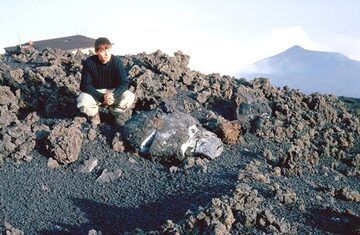
Large bomb ejected from Etna volcano's SE crater.
Ejected fragments of fresh magma larger than 64 mm in diameter, often shaped aerodynamically during their flight.
Volcanic bombs are lava fragments larger than 64 mm in diameter that were ejected while still viscous and partially molten. Many bombs acquire rounded aerodynamic shapes during their travel through the air. Volcanic bombs include breadcrust bombs, ribbon bombs, spindle bombs (with twisted ends), spheroidal bombs, and "cow-dung" bombs.
Volcanology
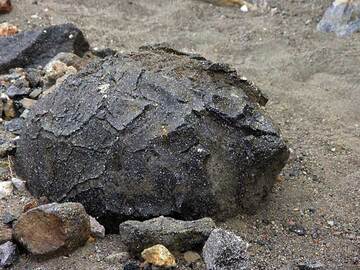
Breadcrust bomb, ca. 50 cm long, from Lokon volcano (N-Sulawesi, Indonesia)
Volcanic bomb with a cracked surface, similar to bread, caused by the slow expansion of the interior gas bubbles while cooling.
A breadcrust bomb is a volcanic bomb with a cracked and checkered surface, sometimes resembling the surface of a loaf of bread. The cracks develop when the outer surface of a partially molten lava fragment cools to form a brittle surface and then subsequently cracks as the hot interior expands due to the continued growth of gas bubbles.
Minerals
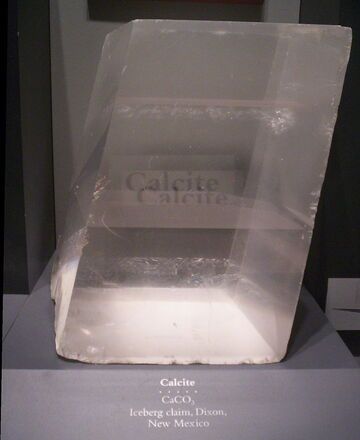
Large crystal of Calcite on display at the National Museum of Natural History in Washington, DC. With its special property of showing double refraction, it is also known as Icelandic Spar.
Calcite is a very common carbonate mineral and the most stable form of calcium carbonate (CaCO3).
|
| | Name | calcite |
| Category | |
| Formula | CaCO3 |
| Crystal system | trigonal |
| Color | typically white to colorless; sometimes also gray, yellow, brown, orange, red, green or even blue |
| Streak | white |
| Luster | vitreous to pearly |
| Crystal habit | crystalline, granular, stalactitic, concretionary, massive, rhombohedral |
| Mohs hardness | 3 (definition mineral) |
| Specific weight | 2.7 |
| Uses | production of lime (industrial scale), acid neutralization, abrasive, soil conditioner, high-grade optical instruments |
| Other | |
Other polymorphs of calcium carbonate are the minerals aragonite and vaterite. Aragonite will change to calcite at 380–470 °C, and vaterite is even less stable.
Volcanology
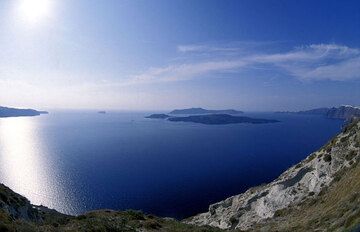
View of the 13x8km large caldera of Santorini, Greece, formed during several Plinian eruptions including the Minoan eruption around 1613 BC.
Large crater, usually several kilometers across, formed by the collapse of the roof of a magma chamber emptied by large explosive eruptions.
A caldera is a large, usually circular depression at the summit of a volcano formed when magma is withdrawn or erupted from a shallow underground magma reservoir. The removal of large volumes of magma may result in loss of structural support for the overlying rock, thereby leading to collapse of the ground and formation of a large depression. Calderas are different from craters, which are smaller,...
Volcanology
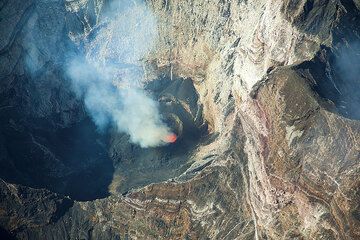
Marum's crater on Ambrym volcano, containing a small lava lake.
A depression often on the top or the flanks of a volcano usually created by explosions of lava from the vent.
Related keywords (1):
calderaGeology
The outermost layer of the Earth, ranging from about 5 to 65 km in thickness worldwide, composed of plutonic, metamorphic, sedimentary and volcanic rocks.
There are two main types of crust: oceanic crust, which is thin (5-10 km) and consists primarily of basalt, diabase, and gabbros. It is formed continuously at oceanic spreading centers.
Continental crust is typically from 30-50 km thick and consists of intrusive rocks (e.g. granites) and metamorphic (e.g. shists, gneiss) rocks at depth and sedimentary and volcanic rocks often forming its surface....
Earthquakes
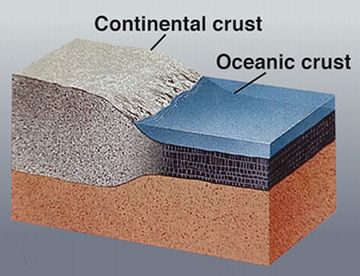
Continental and oceanic crust (image: USGS)
The earth's crust is the outermost major layer of the earth, which forms its varied surface both above and under water that we live on. Its thickness ranges from about 10 to 65 km worldwide. The uppermost 15-35 km of crust is brittle enough to produce earthquakes.
The crust is composed by magmatic, sedimentary and metamorphic rocks. There are two major types of crust: oceanic and continental crust.
Oceanic crust is usually less than 10 km thick and primarily composed of volcanic rocks rich in iron and magnesium (called: mafic rocks). Oceanic crust is much thinner and heavier than continental crust, having a mean density of approx. 3.0 grams per cub...
Geology
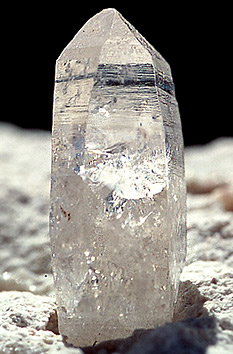
Quartz crystal from the Greek volcano island Milos
In chemistry, mineralogy, and materials science, a crystal is a solid in which the constituent atoms, molecules, or ions are packed in a regularly ordered, repeating pattern extending in all three spatial dimensions.
In chemistry, mineralogy, and materials science, a crystal is a solid in which the constituent atoms, molecules, or ions are packed in a regularly ordered, repeating pattern extending in all three spatial dimensions.
The word crystal originates from the Greek word κρύσταλλος (krystallos) meaning clear ice, as it was thought to be an especially sol...
Volcanology
Dacite is an igneous, volcanic rock with a high iron content found at many lava-domes.
Dacite (pronounced /deɪsaɪt/) is an igneous, volcanic rock with a high iron content. It is intermediate in compositions between andesite and rhyolite, and, like andesite, it consists mostly of plagioclase feldspar with biotite, hornblende, and pyroxene (augite and/or enstatite). It has an aphanitic to porphyritic texture with quartz as rounded, corroded phenocrysts, or as an element of t...
Volcanology
A sudden collapse of volcanic material from an unstable side of a volcano. Debris avalanches are a particularly violent type of pyroclastic flows (in its broader meaning).
Related keywords (1):
pyroclastic flowVolcanology
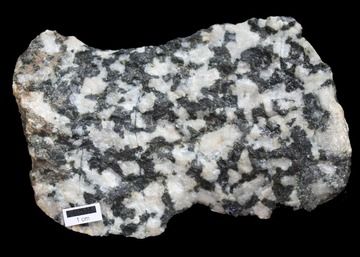
Diorite sample (image: Michael C. Rygel via Wikimedia Commons)
Diorite is an intrusive igneous rock of intermediate silica content (53-63%). It is the equivalent of its extrusive (volcanic) counterpart andesite.
Diorite is composed principally of the silicate minerals plagioclase feldspar (typically andesine), biotite, hornblende, and/or pyroxene. The chemical composition of diorite is intermediate between gabbro and granite.
Earthquakes
An earthquake (also called quake, tremor or temblor, rumbling etc) is the shaking of the surface of the earth resulting from a sudden release of energy in the Earth's interior, usually by sudden movements along fault lines. This movement releases energy that propagates as seismic waves.
The size of earthquakes is determined by the amount of energy released in this process. It can range in size between many orders of magnitude and is commonly given as a number on the logarithmic Richter scale. It ranges from so tiny that they are not felt and can be only detected by the most sensitive modern instruments (seismometers) to so strong that entire regions are shaking violently.
Volcanology: effusive (volcanic) eruption

Lava flow at Mt Etna volcano - a typical effusive eruption
Effusive means flowing out of lava as opposed to explosive eruptions.
If magma is sufficiently fluid and if it is not framented by expanding gasses when reaching the surface vent, it can erupt to form lava flows. This is called effusive eruption. The opposite of effusive is explosive, i.e. fragmentation of magma.
Earthquakes
The point on the Earth's surface vertically above the point (focus or hypocenter) in the crust where an earthquake occurs, i.e. where the seismic rupture nucleates.
Related keywords (1):
hypocenterVolcanology: explosive (volcanic) eruption
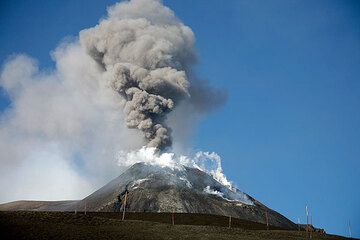
A small explosive eruption at Mt Etna volcano
Explosive eruptions occur, when the erupting magma is ejected as fragments into the air, as opposed to effusive eruptions producing lava flows.
Explosive eruptions are called so, when the erupting magma is fragmented when exiting the conduit. The reason are expanding gasses from the magma itself or external water e.g. from an aquifer. The resulting fragments of the magma itself are called tephra, and consist in small and large pieces: Ash, lapilli and bombs are the typical products of explosive eruptions.
The reason for explosive eruptio...
Earthquakes

Illustration of the main types of tectonic faults (source: USGS)
A fault is a fracture in the rigid crust of the earth, along which the two blocks on either side have moved relative to each other and often may do so again in the future. When blocks move along a fault, tectonic earthquakes are generated.
Depending on the movement, there are strike-slip faults (side-wards movement), normal faults (caused by extension), and reverse or thrust faults (caused by compression). A reverse fault with a small dip angle is called a thrust fault.
Minerals
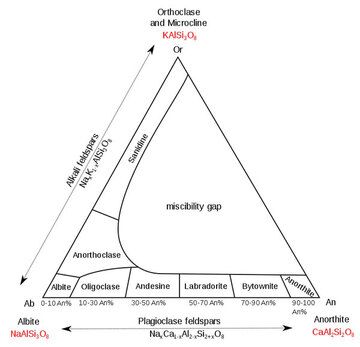
Compositional phase diagram of the different minerals that constitute the feldspar solid solution. Image credit: Muskid / CC BY-SA (https://creativecommons.org/licenses/by-sa/4.0)
Feldspars are a group of closely related rock-forming silicate minerals that are by far the most common in the earth's crust, making up about 41% of its weight.
Feldspar is the most common mineral formed during crystallization of magmas and almost always present in magmatic rocks.
Chemically, the feldspar minerals primarily bind varying proportions of the most common light elements potassium (K), sodium (Na), calcium (Ca), and aluminum (Al) ions, into a crystal lattice of silica (Si) ions.
|
| | Name | feldspar |
| Category | |
| Formula | KAlSi3O8 – NaAlSi3O8 – CaAl2Si2O8 |
| Crystal system | triclinic |
| Color | pink, white, gray, brown, blue |
| Streak | white |
| Luster | vitreous |
| Crystal habit | |
| Mohs hardness | 6.0–6.5 |
| Specific weight | 2.55–2.76 |
| Uses | Feldspar is a common raw material used to produce glass and ceramics. To lesser extent, it is used in filters, paints, plastics, and rubber. |
| Other | |
Feldspars are divided into several groups, based on their chemical compositions of potassium (K), sodium (Na) and calcium (Ca). Thus, there are 3 end-members and numerous intermediate compositions:
- potassium: (K-spar) endmember KAlSi
3O
8
- albite: NaAlSi
3O
8
- anorthite: CaAl
2Si2O
8
Intermediates between K-feldspar and albite (...
Volcanology
A fissure vent, also known as a volcanic fissure or simply fissure, is a linear volcanic vent through which lava erupts.
A fissure vent, also known as a volcanic fissure or simply fissure, is a linear volcanic vent through which lava erupts, usually without any explosive activity. The vent is usually a few meters wide and may be many kilometers long. Fissure vents can cause large flood basalts and lava channels. This type of volcano is usually hard to recognize from the ground and from outer space because it has no ...
Earthquakes
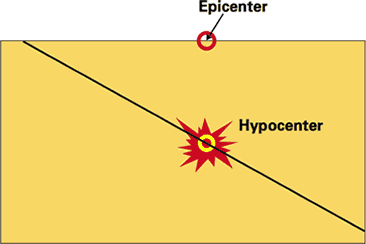
Epicenter and hypocenter of an earthquake (Source: USGS earthquake glossary)
Earthquakes
Foreshocks are smaller earthquakes that precede the largest earthquake in a series, which is termed the mainshock. Not all earthquakes arre preceded by foreshocks.
Foreshocks are earthquakes of varying magnitudes and intensities which precede a larger and stronger earthquake. This larger and stronger earthquake is called the
main shock. Earthquakes or a series of quakes in one area cannot often be immediately identified as a foreshock. By definition, a main shock should have occurred first before any foreshocks and aftershocks can be identified.
The ...
Geology
Fossils are the mineralized or otherwise preserved remains or traces (such as footprints) of animals, plants, and other organisms.
Fossils (from Latin fossus, literally "having been dug up") are the mineralized or otherwise preserved remains or traces (such as footprints) of animals, plants, and other organisms. The totality of fossils, both discovered and undiscovered, and their placement in fossiliferous (fossil-containing) rock formations and sedimentary layers (strata) is known as the fossil record. The study of fossils a...
Volcanology
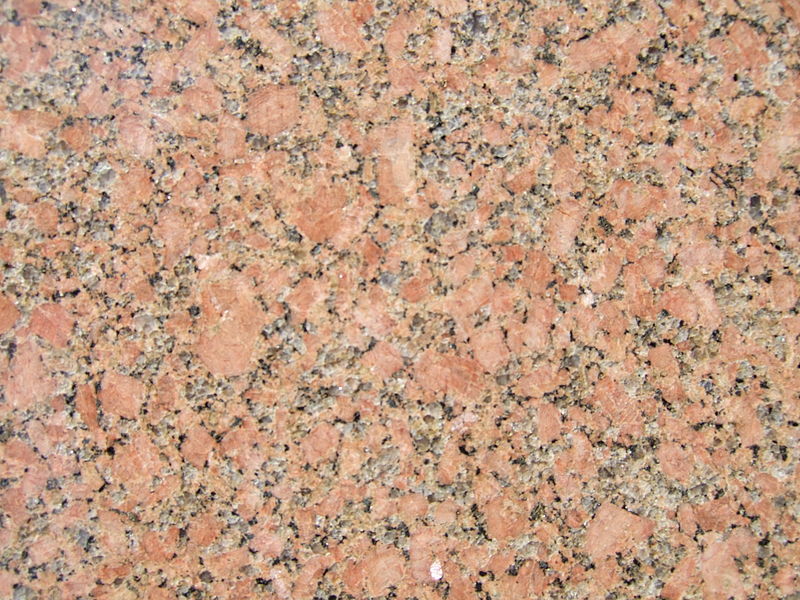
Pink granite (image: Friman / Wikimedia Commons)
Granite is the most well-known and one of the most common intrusive magmatic (plutonic) rock type. It is formed when an intrusion of viscous magma with high silica content (68-75 wt %) remains under the surface of the earth, where it cools and crystallizes slowly inside the crust.
Granite is the equivalent of its extrusive (volcanic) rock type rhyolite. It is granular and coarse-grained in texture. Its principal minerals are feldspars, quartz, and mica.
Granites can be predominantly white, pink, or gray in color, depending on their mineralogy.
Minerals: hauyn crystals
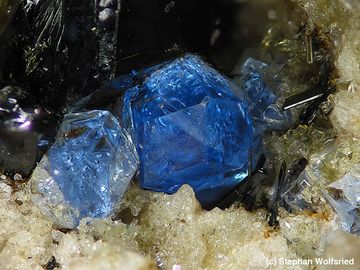
Hauyn crystals from the German volcano Laacher See (photo: Stefan Wolfsried)
Hauyn is a blue mineral, found f.e. in the pumice of the Laacher See eruption in Germany
Hauyne, haüyne or hauynite is a tectosilicate mineral with sulfate and chloride with formula: (Na,Ca)4-8Al6Si6(O,S)24(SO4,Cl)1-2. It is a feldspathoid and a member of the sodalite group. Hauyne crystallizes in the isometric system forming translucent, vitreous typically twinned crystals with highly variable color (blue, white, grey, yellow, green, pink). It has a Mohs hardness of 5 to 6 and a spec...
Volcanology
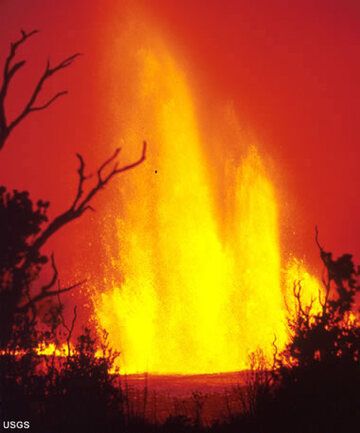
Lava fountain more than 1,000 ft tall from Mauna Ulu, a vent of Kilauea Volcano in Hawaii, on 22 Aug 1969, a spectacular example of a Hawaiian eruption. Photo by D.A. Swanson, HVO / USGS
During a Hawaiian eruption, very fluid, basaltic lava is erupted from the vent as lava fountains and forms lava flows. The fountains are driven by the expanding gasses that were contained in the magma and leave the vent as a jet. Such eruptions are common for hot-spot volcanoes such as Kilauea on Hawai'i.
The lava fountains can reach heights of several hundreds meters, sometimes even more than 1 km. They can last for hours or even days and often occur from fissure vents to form so-called curtains of fire.
The lava spatter that falls back from the fountain can form lava flows if it is still fluid enough, or build up welded spatter ramparts and cinder cones around the vent. Along with the lava foun...
Volcanology
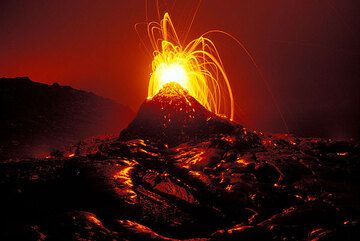
Erupting hornito on Kilauea volcano (Hawaii)
Hornito (Spanish) = "Little oven".
Volcanic hornitos are small (usually a few meters high) rootless spatter cones that form on the surface of a (usually basaltic pahoehoe) lava flow. A hornito develops when lava is forced up through an opening in the cooled surface of a flow (a skylight) and then accumulates around the opening. Typically, hornitos are steep sided and form conspicuous pinnacles o...
Earthquakes

Epicenter and hypocenter of an earthquake (Source: USGS earthquake glossary)
When talking about earthquakes, the hypocenter or focus is the point inside the earth where an earthquake rupture starts. It is often confused with epicenter, which is the is the point directly above it at the surface of the Earth, where the quake is usually felt most strongly.
Related keywords (2):
epicenter -
seismic wavesEarthquakes
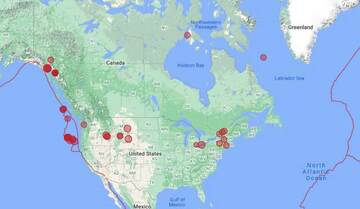
Earthquakes of magnitude 3.2 or higher in or near Canada and northern US during June-July 2021 along with the margins (red lines) of the N-American plate; the quakes far from the plate boundaries are intraplate earthquakes.
Intraplate refers to the location of an event (e.g. an earthquake) in the interior of a tectonic plate.
Intraplate quakes occur within a tectonic plates, sufficiently far from its margins not to be affected or directly caused by the generally more active processes that are taking place along the plate boundaries (subduction, spreading, or transform movments between two plates).
Intraplate quakes are typically the result of releasing long-term accumulated stress in the interior of the crust along ac...
Earthquakes

Earthquakes of magnitude 3.2 or higher in or near Canada and northern US during June-July 2021 along with the margins (red lines) of the N-American plate; the quakes far from the plate boundaries are intraplate earthquakes.
Volcanology

Lava poors out from several vents inside the crater of Pu'u 'O'o, Kilauea volcano, Hawai'i
Molten rock, called magma, is called lava when it reaches the surface during a volcanic eruption. Depending on how the magma erupts, it can form lava flows, lava fountains, lava lakes, or be fragmented into scoria and ash during explosive eruptions.
In a wider use of the term, also the cooled and solidified products of erupted magma are called lava (in form of coherent lava flows, or fragmented tephra).
Magma when it erupts as lava is almost never a completely molten rock, but contains 3 phases: liquid, solid mineral crystals (xenoliths) and gas bubbles, mainly water and carbon dioxide.
The temperature of erupted lava ranges from around ...
Volcanology
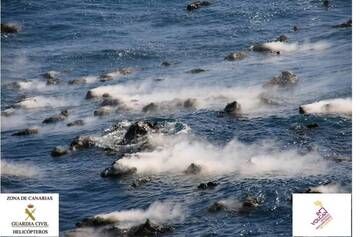
Steaming lava blocks on 27 Nov 2011 near La Restinga (El Hierro) photographed from the air by Guardia Civil / INVOLCAN
Lava balloons are hollow gas-filled pieces of lava floating to the surface above effusive submarine vents. Many lava balloons have been produced and observed during the ongoing 2011-12
shallow submarine eruption at El Hierro.
Floating lava blocks could result from the detachment of pillow-lava edges followed by the ascent of blocks with sufficient gas content. It is also possible that hot, gas-rich lava fragments result from small submarine lava lakes or fountains.
A thin frozen skin of lava seals the gas cavity, and the block might then rise as a hot lava balloon. During ascent, the gas exsolves and nucleates inside ...
Volcanology
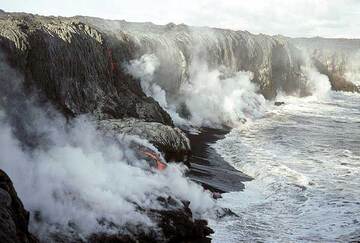
A lava bench in formation: active lava flows covering a small beach, forming a solid cap.
A lava bench is a platform formed by new lava flows that extends the old shoreline; in particular, this can be observed on Hawaii at Kilauea volcano during times when lava is entering the ocean, forming new land.
In their young stadium, benches are highly unstable. They often are underlain only by loose material such as sand and wave-eroded rock. Young benches can collapse at any time, and it is life-threatening to stand on one. Only after a long time, when the pile of material under and in front of the bench is sufficiently stabilized, the bench can be considered new stable land.
Volcanology
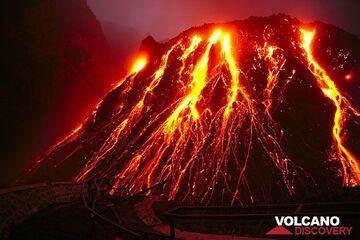
The active lava dome of Kelut volcano (East Java, Indonesia) in Nov 2007
Lava domes are accumulations of highly viscous lava above or near the vent(s) where they were erupted during slow flow, like a sticky glue squeezed out or oozing out from a hole in its container.
Lava domes often take the form of a rounded hill, resembling a dome, but come in many other shapes as well.
Lava domes are very similar to thick lava flows, with the difference being that the lava once erupted from the vent almost doesn't flow at all, and piles up above the vent instead of flowing away downhill or to the side. In fact, there is a transition between thick, sticky lava flows and lava domes, depending on how viscous the lava is, how steep the terrain, the flow rate and other factors. Somet...
Volcanology

Lava flows near the coast from Kilauea volcano, Hawai'i
Lava flows are almost self-explanatory. When magma is erupted in molten or a partially molten state it often has the ability to flow. This is typically the case for basaltic volcanoes such as Hawaii and Etna whose lavas are relatively fluid. Lava flows might form either as primary flows directly flowing out of a vent from the vent or by rapid aggregation of hot fluid spatter that fall back from lava fountains to form a flow.
The appearance of lava flows can vary greatly with chemistry, flow rate, strain rate, temperature, viscosity and other factors. The most simple division can be made between aa lava that usually has a blocky appearance, since the surface of the flow breaks into spiny or blocky pieces, and pahoehoe lava flows, which form a smooth surface and often produce spectacular ropy textures.
Volcanology
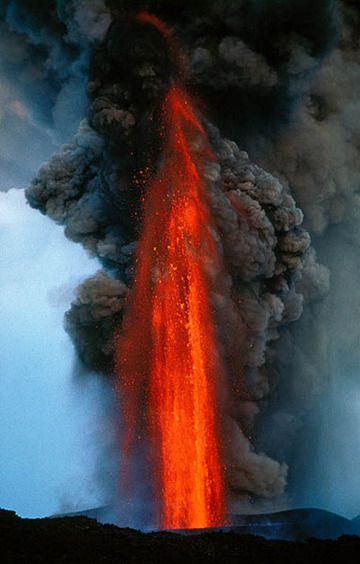
Lava fountain on Etna volcano (June 24, 2001)
Jets of fluid lava propelled into the air from an erupting vent, driven by expanding gasses.
Lava fountains are sustained jets of (usually very) fluid lava into the atmosphere. Lava fountains occur commonly on basaltic volcanoes such as Kilauea, or Etna.
The fountain gains its momentum by the expansion of gas bubbles that dissolve from the magma as pressure falls while it is rising in the conduit.
Heights, appearance, duration and erupted volumes of lava fountains can vary greatly. St...
Volcanology
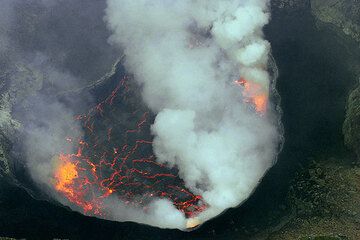
The lava lake of Nyiragongo volcano, DRCongo (Jan. 2006)
Lava lakes are accumulations of larger volumes of liquid lava above one or several vents, usually contained within a crater on the summit of the volcano.
Volcanoes with eruptions that produce long-lasting lava lakes are relatively rare; some volcanoes are famous for their lava lakes: Kilauea (Hawaii), Erta Ale (Ethiopia), Nyiragongo (at present probably the most violent lava lake in the world, about 120 meters wide), Ambrym volcano (Vanuatu), Mt Erebus (Antarctica) and a few others with sometimes smaller lakes.
Volcanology
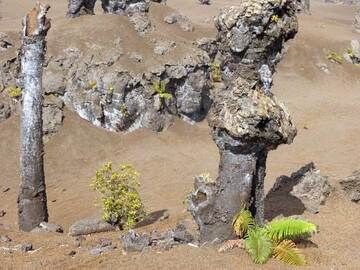
Lava trees on the eastern Rift zone Kilauea volcano, Hawaii
The lava coating around a tree trunk left by an invading liquid lava flow.
When a liquid lava flow invades a forest, often, the lava does not overthrow the larger trees, but flows around their trunks. At the very contact of the hot lava to the bark, a thin layer of the lava is quenched sufficiently to form an isolating coating around the trunk. The tree itself most often burns down slowly, eventually falling down onto the lava.
The typical lava trees are formed when af...
Earthquakes
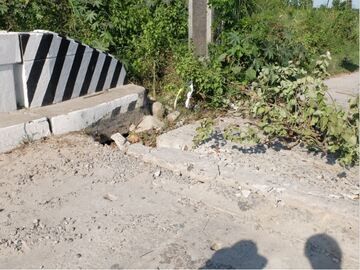
An aftermath of the 2019 Luzon Earthquake in the Philippines. Liquefaction affected the base filling material under the approach to the bridge. This caused that part of the road to slightly subside due to a weakened base. (source: Photograph by Renz Lazatin, 2019)
Very intense earthquakes may sometimes cause the solid ground to act as though it was muddy liquid. This earthquake-induced phenomenon is called Liquefaction. This occurs in areas where the ground is composed of particles with plenty of spaces where water could sneak into (be water-saturated) as in sandy soils and uncompacted soils.
Liquefaction occurs when the very intense shaking of the earthquake causes the pore water pressure in the soil to increase, leading to loss of strength and stability of the soil. This results to the ground acting as though it was liquified.
After the shaking ends, the soil immediately turns solid and holds anything caught sinking in it, in place. Another hazard related to this is the colla...
Volcanology
Molten rock within a volcano or underneath the earth's surface. Once magma reaches the surface it is called lava.
Related keywords (2):
explosive -
laveEarthquakes
A number that characterizes the relative size of an earthquake. Different scales are used, but the most common is the logarithmic Richter scale. where most quakes are between 0 (tiny) and 9 (extremely large quake). Each step on this scale indicates a 10 fold energy increase of an earthquake.
Felt quakes are normally above magnitude 2.5 on this scale.
Magnitude is based on measurement of the maximum motion recorded by a seismograph(sometimes for earthquake waves of a particular frequency), corrected for attenuation to a standardized distance.
Several scales have been defined, but the most commonly used are (1) local magnitude (ML), commonly referred to as œRichter magnitude, (2) surface-wave magnitude (Ms), (3) body-wave magnitude (Mb), and (...
Earthquakes
A mainshock is the largest earthquake in a sequence, sometimes preceded by one or more foreshocks, and almost always followed by many aftershocks.
Related keywords (2):
aftershock -
foreshockMinerals
Minettes are a variety of igneous rock with phenocrysts of biotite, and with or without phenocrysts of hornblende, augite with a high diopside content, and olivine.
Examples where minettes are found include the Navajo Volcanic Field of the Colorado Plateau and the Mexican Volcanic Belt, where he youngest minettes on the earth are found in the Mascota volcanic field.
Volcanology
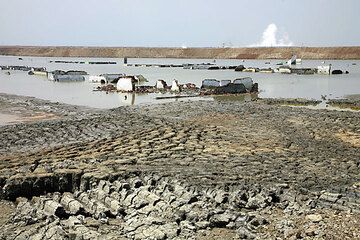
Sidoarjo mud volcano (East Java)
Mud volcanoes are no true volcanoes, but vents that erupt mud, as fine sediemtn is squeezed upwards by prezzurized water, steam and gas escaping from deeper deposits.
A mud volcano is a vent on the surface erupting mud and gas or steam, but no lava. Mud volcanoes are usually not the result of volcanic processes, but more generally related to environments where pressurized deposits at depth occur that release gas and steam, which mixes with fine-grained sediments to form mud. Temperatures are much cooler than at volcanic processes. The largest structures are 10 ...
Volcanology

Obsidian from the Rocce Rosse lava flow on Lipari island (Italy)
Black volcanic glass
Obsidian is a naturally occurring glass formed as an extrusive igneous rock. It is produced when felsic lava extruded from a volcano cools rapidly through the glass transition temperature and freezes without sufficient time for crystal growth. Obsidian is commonly found within the margins of rhyolitic lava flows known as obsidian flows, where cooling of the lava is rapid. Because of the lack of cr...
Minerals
Olivine is one of the earth's most common rock-forming silicate minerals, typically contained in mafic to ultrafafic magmatic rocks with low silica content (e.g. basalt, gabbro, peridotite), which make up much of the earth's upper mantle, the oceanic crust and lava flows etc from basaltic shield volcanoes on land.
Its name refers to its often olive-green color.
|
| | Name | olivine |
| Category | |
| Formula | (Mg2+, Fe2+)2SiO4 |
| Crystal system | orthorhombic |
| Color | Yellowish-green to olive green |
| Streak | None |
| Luster | Vitreous |
| Crystal habit | Massive to granular |
| Mohs hardness | 6.5–7 |
| Specific weight | 3.2-4.5 |
| Uses | |
| Other | |
Chemically, it combines two interchangeable ions of magnesium (Mg2+) or iron (Fe2+) with one silica ion (Si4+) in a densely-packed crystal lattice. The two end-members from this compositional range are forsterite (magnesium-olivine, Mg2SiO4) and and fayalite (iron-olivine, Fe2SiO4). In rare cases, Mg/Fe can also be replaced by calcium (Ca), manganese (Mn), or nickel (Ni).
Earthquakes
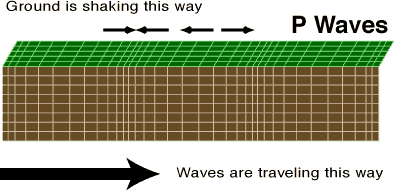
Illustration of a P-wave (image: USGS)
The P wave (short for primary wave, also called pressure or compressional wave) is the seismic wave that shakes the rocks forth and back in the same and opposite direction of the propagation direction (longitudinal).
The primary (P) waves of earthquakes are the same type of waves as the more familiar sound waves. Both are waves propagating spherically away from its source through a compressible medium (rocks, fluids and gasses) where particles are swinging in the same and opposite direction of the wave propagation.
Typical speeds of P-waves from earthquakes are between 1450m/s in water and 5000m/s in granite....
Volcanology: phreatomagmatic activity
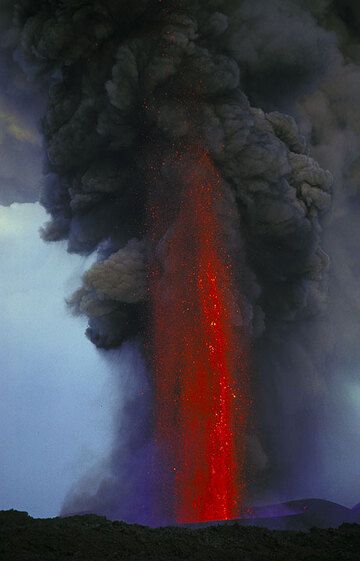
Lava fountain at Etna during the 2001 eruption. The activity is phreatomagmatic in origin, which explains the large amount of ash involved in the fountain: the rising water on its way meets wet layers where the contact between water and magma produces violent fragmentation.
Volcanic activity where fresh magma AND external water are involved.
Phreatomagmatic activity means that erupting magma reacts with external water, e.g. ground water, lake water, sea water etc. In contrast, if only magma is erupted and driven only by gasses originally contained in the magma, it is called magmatic activity. If no magma itself erupts, but heated ground water drives explosions and eruptions of older material, the activity is called phreatic.
Volcanology
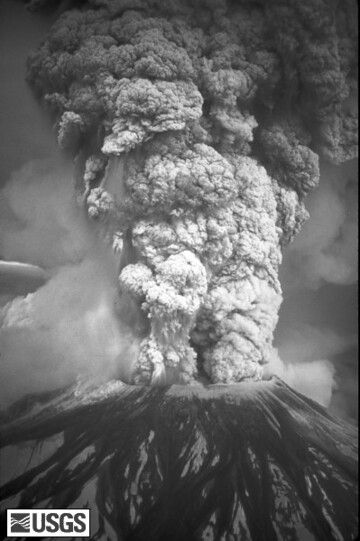
Plinian eruption of Mt. St. Helens on May 18, 1980 (USGS Photograph taken on May 18, 1980, by Donald A. Swanson)
The most explosive and largest type of volcanic eruptions. Plinian eruptions erupt more than 1 cubic kilometer of magma often within less than a few days and produce ash columns that can reach 20-50 km height.
Plinian eruptions are large explosive events that form enormous dark columns of tephra and gas high into the stratosphere (>11 km). Such eruptions are named for Pliny the Younger, who carefully described the disastrous eruption of Vesuvius in 79 A.D. This eruption generated a huge column of tephra into the sky, pyroclastic flows and surges, and extensive ash fall. Many thousands of people evacuate...
Earthquakes

Illustration of a P-wave (image: USGS)
Volcanology: pumice stone
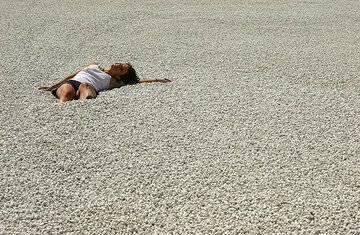
Our tour guide Marta posing in Lipari's pumice...
Pumice is a very light, porous volcanic rock that forms during explosive eruptions. During the eruption, volcanic gases dissolved in the liquid portion of verz viscous magma expand very rapidly to create a foam or froth; the liquid part of the froth then quickly solidifies to glass around the gas bubbles.
The volume of gas bubbles is usually so large that pumice is lighter than water and floats.
Pumice is an important industrial mineral used to produce high-quality cement and lightweight, isolating building materials.
Pumice is a textural term for a volcanic rock that is a solidified frothy lava composed of highly microvesicular glass pyroclastic with very thin, translucent bubble walls of extrusive igneous rock. It is commonly, but not exclusively of silicic or felsic to intermediate in composition (e.g. rhyolitic, dacitic, andesite, pantellerite, phonolite, trachyte), but occurrences of basaltic and other com...
Volcanology

Pyroclastic flow travelling down the Krasak ravine at Merapi volcano on 27 May 2006.
Fluid avalanche of turbulently mixed ash, lava and or rock fragments, and air, that flows down the flanks of a volcano, driven by gravity. Pyroclastic flows are usually very hot and highly destructive.
A pyroclastic flow is a ground-hugging avalanche of hot ash, pumice, rock fragments, and volcanic gas that rushes down the side of a volcano as fast as 100 km/hour or more. The temperature within a pyroclastic flow may be greater than 500°C, sufficient to burn wood. Once deposited, the ash, pumice, and rock fragments may deform (flatten) and weld together because of the intense heat and the weight...
Minerals
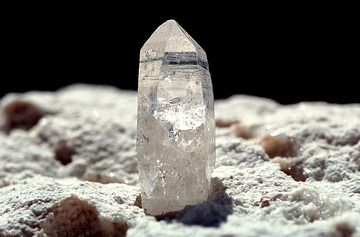
Quartz from Milos island (Greece)
Quartz (crystalline SIO2) is the most abundant mineral in the Earth's continental crust.
Quartz is made up of a lattice of silica (SiO2) tetrahedra. Quartz has a hardness of 7 on the Mohs scale and a density of 2.65 g/cm³.
Pure quartz is colorless or white, colored varieties include rose quartz, amethyst, smoky quartz, milky quartz, and others. Quartz goes by an array of different names. The most important distinction between types of quartz is that of macrocrystalline (individual ...
Volcanology
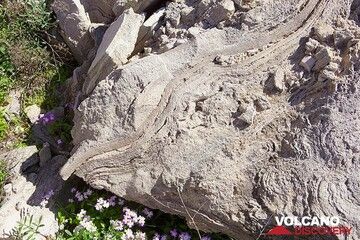
Rhyolite from Milos island (Greece)
A type of highly viscous magma with high silica content; it is found as pumice (in airfall deposits or ignimbrites), lava or obsidian. Rhyolite is also the name given to the volcanic rock formed from rhyolitic magma.
Geology
Sediment is any particulate matter that can be transported by fluid flow and which eventually is deposited as a layer of solid particles on the bed or bottom of a body of water or other liquid.
Sediments are also transported by wind (aeolian processes) and glaciers. Desert sand dunes and loess are examples of aeolian transport and deposition. Glacial moraine deposits and till are ice transported sediments. Simple gravitational collapse also creates sediments such as talus and mountainslide deposits as well as karst collapse features. Each sediment type has different settling velocities, ...
Earthquakes

Diagram showing the elements of an earthquake. (source: Tarbuck, Lutgens, and Tasa. 2012. Essentialsof Geology. 11th Ed. Page 337)
During an earthquake, large amounts of energy are released from the hypocenter or focus (i.e. point where the quake occurs) in the form of seismic waves. These cause the vibrations felt during a proper quake.
As a thought experiment, try imagining throwing a pebble in the middle of pond. Ripples will form from the point of contact between the pebble and the water surface, and propagate outwards ...
Earthquakes
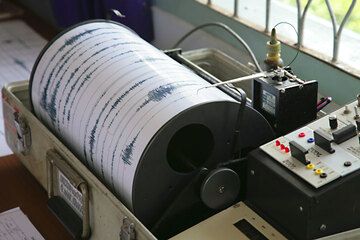
A seismograph at a volcano observatory in Indonesia
An instrument that displays vibrations and movements in the Earth = the recording of a seismometer.
Traditional seismographs transfer the recorded shaking to a precise pencil that writes a continuous shake line onto a sheet of paper wrapped around a turning drum.
The drum slowly turns at steady speed and at the same time, the pencil is slowly moved horizontally, so that the line forms a continuous spiral line on the paper until it is filled. Each turn of the drum (or each line on the unwrapped...
Volcanology
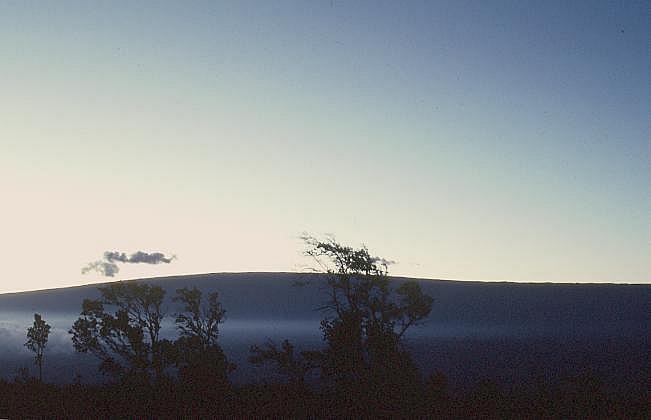
Mauna Loa shield volcano (Big Island, Hawaii)
Shield volcanoes are volcanoes that mainly erupt fluid (usually basaltic) lava flows that are able to travel over long distances and thus construct over time broad, gentle slopes. They are called shield volcanoes, because they resemble the shape of a warriors'shield.
Shield volcanoes are volcanoes that mainly erupt fluid (usually basaltic) lava flows that are able to travel over long distances and thus construct over time broad, gentle slopes. They are called shield volcanoes, because they resemble the shape of a warriors'shield.
While stratovolcanoes, the other major morphological type of volcanoes, are representative for most subduction-type volcanoes, sh...
Volcanology
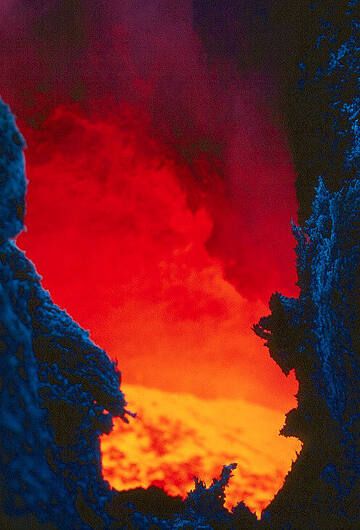
Skylight on Etna volcano (Italy)
Skylights are openings in the roof above a lava tube, from where the flowing lava flow can be seen. Usually, these holes are caused by the simple collapse of the roof of the tube.
Related keywords (1):
Coulée de laveVolcanology: volcanic smoke ring, gas ring, steam ring
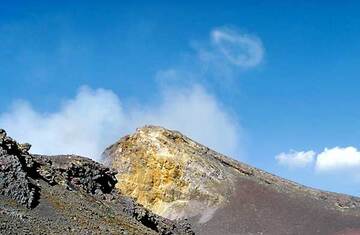
Etna's Bocca Nuova crater in 2000, emitting smoke rings
A rare phenomenon, where a visible vortex ring of steam and gas is expelled from a volcanic vent.
Under special conditions, gas and steam expelled from a vent can form gas rings. It probably requires a particular geolometric configuration of a circular vent exit, as well as expulsion of gas in individual puffs with just the right velocity.
This phenomenon is quite rare, but has been witnessed at several volcanoes, including Stromboli and Etna. At Etna, a spectacular period lasting several mo...
Earthquakes
The amount of deformation (change in size, shape, or volume) experienced by a rock as a result of stress.
There are three stages of deformation that rocks pass through when stress is applied:
- Elastic: strain is reversible
- Ductile: strain is irreversible
- Fracture: strain is irreversible and the rock has broken
Related keywords (1):
stressEarthquakes
The force per unit area applied to a rock.
There are different types of stress:
- Uniform: when forces are acting equally in all directions
- Tensional or Extensional: stretches the rock
- Compressional: squeezes the rock
- Shear: causes slippage of the rock along a plane
Related keywords (1):
strainVolcanology
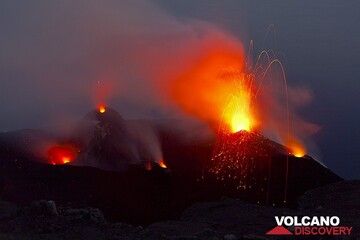
Strombolian eruptions from vents of Stromboli volcano, Eolian Islands, Italy
Strombolian eruptions are the smallest type of explosive eruptions. Strombolian eruptions consist of intermittent, generally relatively small explosions or weak pulsating fountains of fluid (usually basaltic) lava from a single vent or crater.
They are called so after the type locality of Stromboli volcano (Eolian Islands, Italy), which has been in strombolian activity for probably more than 2000 years.
An individual strombolian explosion is the result of sudden release of volcanic gasses. The typical rhythmic occurrence is caused by gradual accumulation of gas bubbles beneath a weakly solidified plug at the top of the magma column at the vent surface until the gas pressure is high enough to erupt through it, ejecting with it both solid and liquid spatter from the magma.
Earthquakes
The adjective "tectonic" refers to processes, properties, or resulting features related to the deformation (breaking and slow, plastic deformation) of rocks over large sections of the upper mantle and crust (lithosphere).
It is usually applied to large-scale features and processes, in the km scale and app. Smaller miniature tectonic processes are sometimes called micro-tectonic.
Related keywords (1):
intraplateEarthquakes

Illustration of the main types of tectonic faults (source: USGS)
Volcanology
Tephrite is an type of volcanic (extrusive) rock with low silica content, similar to basalt, but containing foid minerals (e.g. nephelinite, leucite) along with plagioclase.
The composition of tephrite is called tephritic.
Volcanology
Tephritic refers to the mineral composition of tephrite, an type of volcanic (extrusive) rock with low silica content, similar to basalt, but containing foid minerals (e.g. nephelinite, leucite) along with plagioclase.
Volcanology
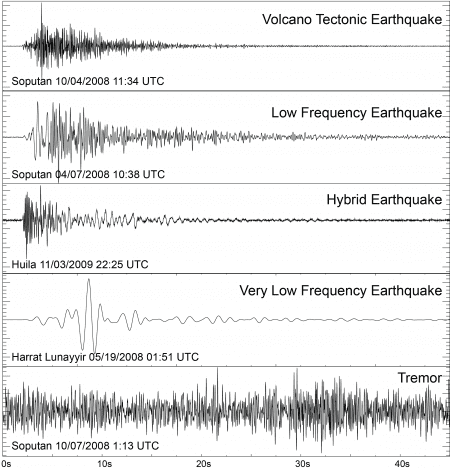
Seismogram signal examples from volcanic earthquakes: Volcano Tectonic (VT) Low Frequency (LF), hybrid (mix of VT and LF), Very Low Frequency (VLF), and Tremor. Volcano name/date in lower left. (image: USGS)
Volcanology
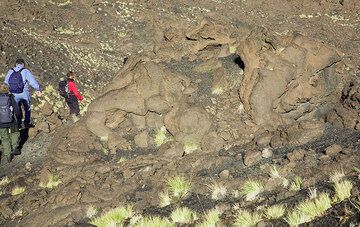
Tumulus with strange shapes, on the lava flow field of the 1614-24 eruption of Mt. Etna, Italy.
From Latin "tumulus" = "little hill", tumuli (pl.) are uplifted sections of pahoehoe lava crust caused by pressure from still fluid lava accumulating beneath the hardened crust.
Tumuli are a characteristic feature of all pahoehoe lava flow fields, such as prominent on Kilauea volcano, Hawaii, but also many other basaltic volcanoes including Etna.
Volcanology: Volcanic Ash Advisory Centre
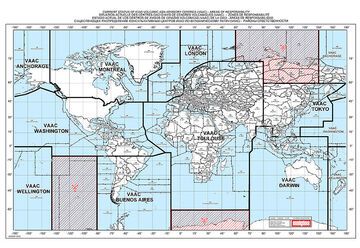
Coverage of the globe by the 9 VAAC.
Volcanic Ash Advisory Centers (VAAC) are research centres who monitor volcanic ash clouds in real time. Each time, a volcano erupts a significant ash cloud, short reports are issued and transmitted directly to air control centres. The 9 VAAC are located in London, Toulouse, Tokyo, Darwin, Anchorage, Washington, Montreal and Buenos Aireas and collectively cover most of the globe.
The Volcanic Ash Advisory Centers (VAAC) are groups of experts and government-funded bodies to montor volcanic ash clouds all over the planet in real time. As Europe experienced in April 2010, volcanic ash clouds are hazardous for aircraft and must be avoided to fly through, even if that means cancellation of flights.
As of 2010, there are 9 VAAC located in different areas and each focussing m...
Volcanology
The ability of a liquid to flow. Basalt magma has a relatively low viscosity making it runny, whereas rhyolite magma has a high viscosity making the magma thick and sticky.
Related keywords (2):
explosive -
lava domeVolcanology: volcanic dike
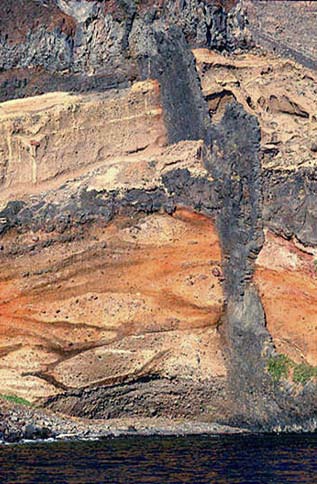
Exposed volcanic dike on Santorini (Greece)
Pathways of rising magma inside vertical fissures.
Dikes are imaginable as the veins of a volcano, the pathways of rising magma. A dike is called a -usually more or less vertical- flat, sheet-like magma body that cuts unconformingly through older rocks or sediments.
Most dikes can be described as fractures into which magma intrudes or from which they might erupt. The fracture can be caused by the intrusion of pressurized magma, or vice versa, ...
Volcanology

Seismogram signal examples from volcanic earthquakes: Volcano Tectonic (VT) Low Frequency (LF), hybrid (mix of VT and LF), Very Low Frequency (VLF), and Tremor. Volcano name/date in lower left. (image: USGS)
Volcanic tremor is a continuous seismic signal with regular or irregular sine wave appearance and low frequencies (0.5-5 Hz).
Volcanic tremor is usually in the form of harmonic tremor which has a very uniform appearance, whereas spasmodic tremor is pulsating and consists of higher frequencies with a more irregular appearance.
Tremor can be caused by different processes inside the volcano, including resonance triggered by magma flowing through cracks and vents, or continuous low-frequency earthquakes so closely spaced th...
Volcanology
A volcaniclastic rock or loose deposit made of (older) volcanic fragments.
Volcanology
The science of studying volcanoes.
Volcanology comprises the study of volcanoes and volcanic phenomena and is mostly regarded as a sub-part of geology, but is interwoven with other science disciplines as well: chemistry, physics, but also sociology, history, archaeology.
Volcanology
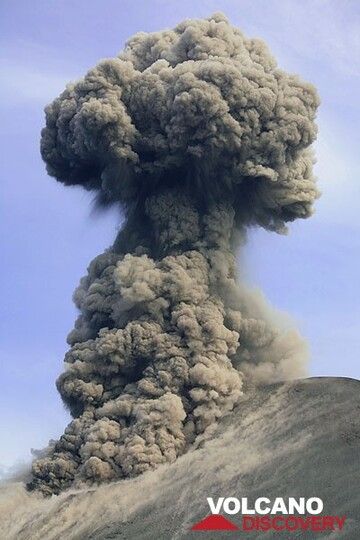
Eruption column from a vulcanian eruption on Krakatau
A vulcanian (note the different term from "volcanic") eruption is an intermediately violent type of explosive eruption, stronger than strombolian explosions but much weaker than Plinian eruptions.
During vulcanian eruptions, a relatively large solid plug is ejected when magmatic gas pressure that had build up beneath it overcomes the strength of the plug.
In the same way as Stromboli island for strombolian eruptions, the term vulcanian was coined after the neighboring island of Vulcano in the Eolian Islands, where such eruptions had been observed during the eruption in 1888.
Vulcanian eruptions can follow longer or shorter intervals of repose during which gasses in the magma beneath the plug slowly build up. The smallest vulcanian explosions typically produce eruption columns of approx 1-2 km height, while larger ones approaching sub-plinian size can erupt columns reaching several to more than 10 kilometers height.
Often, the eruptions are accompanied by violent gun...
Earthquakes
The Wadati-Benioff zone (also known as Benioff zone) is a downward dipping zone of earthquakes that corresponds to the descending plate at a subduction zone.
Volcanology
An inclusion of foreign rock in an igneous rock.
Xenoliths in volcanic rocks are often pieces of the volcano's (non-volcanic) substratum picked up by, engulfed within and erupted with the rising magma.
Minerals
Zeolites are alumino-silicate minerals where usually water molecules are built into the crystal cructure. Zeolites are commonly forming as secondary minerals in volcanic rocks.
Zeolites (Greek, zein, "to boil"; lithos, "a stone") are hydrated aluminosilicate minerals and have a micro-porous structure.
The term was originally coined in the 18th century by a Swedish mineralogist named Axel Fredrik Cronstedt who observed, upon rapidly heating a natural mineral, that the stones began to dance about as the water evaporated. Using the Greek words which mean "stone that boil...
